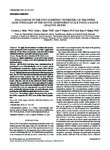Evaluation of the Clinimetric Properties of the Upper Limb Subscales of the Motor Assessment Scale Using a Rasch Analysis Model.
| dc.contributor.author | Miller, KJ | en |
| dc.contributor.author | Slade, A | en |
| dc.contributor.author | Pallant, J | en |
| dc.contributor.author | Galea, M | en |
| dc.date.accessioned | 2013-01-14T16:57:06Z | |
| dc.date.available | 2013-01-14T16:57:06Z | |
| dc.date.issued | 2010-04-01 | en |
| dc.identifier.issn | 1650-1977 | en |
| dc.identifier.uri | http://hdl.handle.net/10026.1/1243 | |
| dc.description.abstract |
OBJECTIVES: To apply Rasch analysis to evaluate the psychometric properties of the composite score of the 3 upper limb subscales of the Motor Assessment Scale (UL-MAS) when administered in the acute/subacute phase post-stroke. DESIGN: Prospective data collection of UL-MAS scores. PARTICIPANTS: Eighty Eighty individuals a mean of 64.8 days (standard deviation 53.3; range 4-193 days) following the onset of unilateral stroke. METHODS: All UL-MAS test items were administered in 30 participants assessed longitudinally over 3 occasions, and in 50 participants assessed on a single occasion. These 140 observations were pooled to be evaluated using Rasch analysis. RESULTS: With the elimination of the wrist radial deviation test item, the UL-MAS demonstrated uni-dimensionality with no significant test item response bias. The test item difficulty hierarchy was validated in the Upper Arm and Hand Movements subscales, but not in the Advanced Hand Activities subscale. The acceptable floor (14%) and ceiling (9%) effects and the high Person Separation Reliability Index (0.96) indicated that the scale was appropriately targeted to discriminate statistically between groups of acute/subacute stroke participants with differing upper limb motor recovery. CONCLUSION: The findings support the psychometric properties of the composite UL-MAS score in this clinical population. | en |
| dc.format.extent | 315 - 322 (637) | en |
| dc.language | English | en |
| dc.language.iso | English | en |
| dc.publisher | Foundation for Rehabilitation Information | en |
| dc.subject | Rasch | en |
| dc.subject | psychometrics | en |
| dc.subject | upper limb | en |
| dc.subject | motor assessment scale | en |
| dc.title | Evaluation of the Clinimetric Properties of the Upper Limb Subscales of the Motor Assessment Scale Using a Rasch Analysis Model. | en |
| dc.type | Journal Article | |
| plymouth.issue | 4 | en |
| plymouth.volume | 42 | en |
| plymouth.publisher-url | http://www.medicaljournals.se/jrm/content/?doi=10.2340/16501977-0519 | en |
| plymouth.publication-status | Published | en |
| plymouth.journal | Journal of Rehabilitation Medicine | en |
| dc.identifier.doi | 10.2340/16501977-0519 | en |
| plymouth.organisational-group | /Plymouth | |
| plymouth.organisational-group | /Plymouth/Faculty of Health: Medicine, Dentistry and Human Sciences | |
| plymouth.organisational-group | /Plymouth/Faculty of Health: Medicine, Dentistry and Human Sciences/School of Health Professions | |
| plymouth.organisational-group | /Plymouth/REF 2021 Researchers by UoA | |
| plymouth.organisational-group | /Plymouth/REF 2021 Researchers by UoA/UoA03 Allied Health Professions, Dentistry, Nursing and Pharmacy | |
| dc.rights.embargoperiod | Not known | en |
| rioxxterms.versionofrecord | 10.2340/16501977-0519 | en |
| rioxxterms.licenseref.uri | http://www.rioxx.net/licenses/all-rights-reserved | en |
| rioxxterms.type | Journal Article/Review | en |


